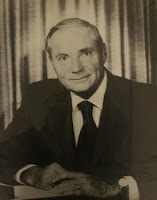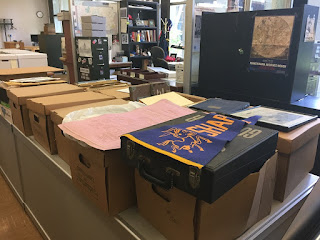Appraisal
Earlier this year Richard Shapp, son of former Pennsylvania Governor Milton J. Shapp (1912-1994), contacted the State Archives about donating some of his father’s personal papers, then housed in two five-foot-tall filing cabinets in his garage. The first step in the records acquisition process is appraisal. An archivist has to determine the historical value of records based on several different criteria including research potential, age/scarcity, and the size of the collection. Knowing that the information in those filing cabinets would help to fill out Manuscript Group 309, the Milton J. Shapp Papers, Archives Director David Carmicheal gladly accepted the donation.
 |
| Milton J. Shapp, Governor of Pennsylvania 1971-1979 (PA State Archives) |
Richard Shapp was very knowledgeable regarding not only his father’s political career but also many events of the 1970s and 1980s. He told us about Gov. Shapp’s love for poetry and short stories—two whole filing drawers contained Milton Shapp’s own work—and shared many stories, including his father’s vision for the Peace Corps, which he shared with President John F. Kennedy in the early 1960s. One surprise we received was a folder of information regarding First Lady Muriel Shapp (1919-1999), who had taught Japanese American high school students at the Topaz internment camp in Utah during World War II. Listening to Richard Shapp talk about this collection as we packed it up made me want to process it and read into more detail all of the information we had received.
After we had packed up the van with over 11 cubic feet of papers, film reels and photographs, Mr. Shapp invited us to join him for lunch. While he got everything ready we viewed what his partner referred to as his “Forrest Gump” wall. I can completely see why she calls it that! The upstairs hallway was lined with photographs of our host with some very important people including Anwar Sadat, Queen Elizabeth II, Richard Nixon and Pope Paul VI. [Editor’s note: Shapp, classically trained in opera at the Curtis Institute of Music in Philadelphia, has sung professionally in the U.S. and abroad, alongside such notables as Luciano Pavarotti and Anna Moffo.] Richard Shapp was more than just a donor; he was a generous host and a wealth of knowledge.
 |
| Shapp collection before processing |
When a record is accessioned we are taking legal and physical custody of the materials and establishing intellectual control. Once the new Shapp acquisition was back at the Archives, our first step was to note, in a very general sense, what was in each box. Then Richard Saylor typed up an accession register that included all of the basic information we had gathered thus far: the source and origin, an estimated date range the boxes covered, how many cubic feet of material before processing and what manuscript group it would be accessioned into. From here the boxes and accession register were given to Kurt Bell, who is the Manuscript Group processor in the Collections Management section of the State Archives.
 |
| Kurt Bell and Corine Lehigh examine records |
Processing is the arrangement, description, and housing of archival materials for storage and for use by patrons. First we sorted the boxes into subject groups alphabetically, and then I rehoused the documents into archival boxes. (It is important to use acid-free boxes and folders for long-term preservation; many general use folders and papers will begin to deteriorate rapidly as the years progress, leaving the records unusable.) Once the records were arranged, the next step in processing was to write a general description of the contents of each folder, bearing in mind what researchers would be looking for and what would help them use the materials. This necessitated dividing the groups by subject and then boxing them up in chronological order, which was especially important for files created during Gov. Shapp’s two terms in office.
 |
| Records in new acid-free boxes |
 |
| Researching film from Shapp collection |
 |
| Creating a finding aid for Gov. Shapp's personal papers |
So that’s how a record goes from being in someone’s garage to becoming available for a researcher. It’s an important process to help preserve records for future generations to enjoy. Hopefully this post also helps you think about your own collection of personal papers and how you can make it easy for future generations of your own family to enjoy.



1 comments:
Thanks for this enlightening article. It was quite informative.
Post a Comment